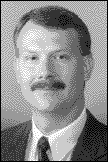From the Executive Director
The power of purpose
 The
recent US presidential election was a good example of how numbers enter
into our everyday lives. It seems
that each day of the campaign brought forth a new poll to predict who would be
our next president. Polling has become big business as part of the election
process. It has
become so ingrained into our culture that we often forget that numbers do not
always tell the whole story.
The
recent US presidential election was a good example of how numbers enter
into our everyday lives. It seems
that each day of the campaign brought forth a new poll to predict who would be
our next president. Polling has become big business as part of the election
process. It has
become so ingrained into our culture that we often forget that numbers do not
always tell the whole story.
Within the AASV, we too are concerned about numbers, but again, numbers do not always tell the whole story. AASV membership has been declining since 1999. The rate of loss has decreased but the trend continues: we are losing more members than we are gaining. There may be several reasons given for this loss, but most are related to the consolidation within the swine industry and the changing demographics of food animal practice.
Declining membership is a difficult issue and there is no easy answer. It is, however, easy to focus on the objective measure of an organization, but more difficult to determine what to do about it. The obvious concern with a shrinking number of members is the threat posed to the viability of the organization. Having never been one to promote hand-wringing and gnashing of teeth, I am always searching for new insight into this issue.
Recently, Feedstuffs1 magazine published a thought-provoking interview with Jim Whitt. Mr Whitt works in the fields of organizational and personal motivation and has a background in cow-calf production and feed sales. In the interview, he focused on issues confronting producers and producer organizations. One of his comments struck a chord, because I believe it applies directly to the AASV. He stated that "the power of an organization is its purpose, not its number of members." He went on further: "The organization will be stronger because its purpose, not its membership role, is strategically important."
On first blush, one might dismiss this statement as nothing more than rationalization for dismissing the decline in membership numbers. With deeper consideration, Mr Whitt's reasoning does indeed have merit for the AASV. Although we are shrinking in numbers, I see no indications that we have diminished in achieving our purpose: increasing the knowledge of swine veterinarians. We have never been a large organization, but we have always been driven by this explicit purpose. It is who we are, whether we have 20,000 members or 20.
If our purpose is important enough, then the AASV will always be an organization of value. It is our purpose that defines our utility for veterinarians and the swine industry, not our membership numbers. Our purpose also defines our mix of benefits and functions of the organization. The challenge is to remain focused on our purpose and on using it to create value for our members. Within this challenge lies the responsibility for AASV to match our benefits and functions to the needs of our members.
I am occasionally asked how many swine veterinarians will be needed in the future. Many predictions have been made about that number. It is frustrating, because I think that it is the wrong question. We need to understand what the swine industry will be in the future and then ask how we accomplish our purpose within that future. The way we do that may not resemble the way we increase the knowledge of swine veterinarians today, but our purpose remains the same.
The issue of a declining number of members should not be viewed as the true measure of the viability of the AASV. It is merely a number that does little to gauge the value or power of the AASV. Power is about serving the interests of our members and making a difference in their professional lives. Our power is in our purpose.
Reference
*1. Whitt J. Accepting change means understanding "why, what." Feedstuffs. 2004;76(41):1, 31.
* Non-refereed reference.
-- Tom Burkgren
